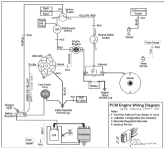PLD-PR-L10 (351CID, 240hp, Ford)
Started the season by firing up great in the barn and starting cold. After running and (reaching 150C), or even just starting and shutting down, the engine won’t catch on re-start. It turns over fine, just won’t catch, even with starter fluid.
Some max-throw throttle pumping usually does the trick eventually, but smells a bit rich like it’s flooding.
Runs fine once once it does start (tops out around 40-45). (Doesn’t run like it’s missing a cyllinder).
Wiggling the distributor wires (to maybe improve contacts), got a strong shock through the insulation of one.
Last year I had some starting problems, but they seemed resolved when I found Rec-90 gas without ethanol. Straight Rec-90 this year, and ran through a can of sea-foam carb-cleaner, plus carb cleaner directly into the carb.
Started the season by firing up great in the barn and starting cold. After running and (reaching 150C), or even just starting and shutting down, the engine won’t catch on re-start. It turns over fine, just won’t catch, even with starter fluid.
Some max-throw throttle pumping usually does the trick eventually, but smells a bit rich like it’s flooding.
Runs fine once once it does start (tops out around 40-45). (Doesn’t run like it’s missing a cyllinder).
Wiggling the distributor wires (to maybe improve contacts), got a strong shock through the insulation of one.
Last year I had some starting problems, but they seemed resolved when I found Rec-90 gas without ethanol. Straight Rec-90 this year, and ran through a can of sea-foam carb-cleaner, plus carb cleaner directly into the carb.


